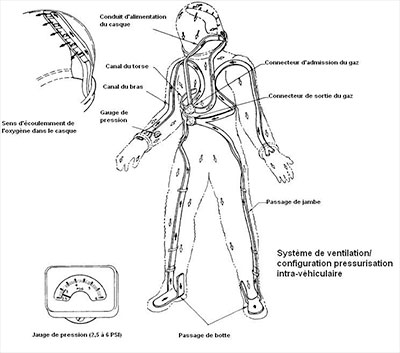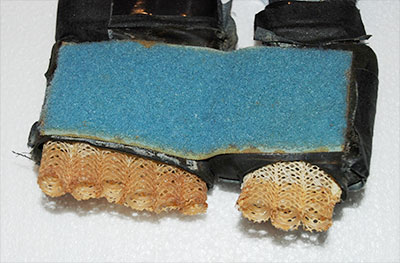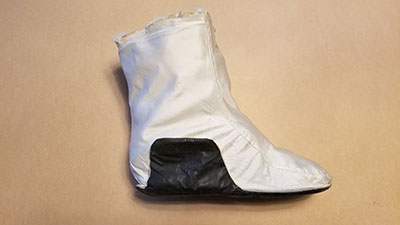|
Author
|
Topic: Apollo A7L spacesuit internal sole
|
Apolloman
Member Posts: 208
From: Ledignan, Gard (30), France
Registered: Mar 2009
|
 posted 02-18-2024 06:03 AM
posted 02-18-2024 06:03 AM
   
According to this diagram (sorry, it's in French), there is a ventilation passage in the Apollo A7L spacesuit at the astronaut's feet. Does anyone have a picture of it to see what it really looks like? Is it like some kind of sole made in the same way as O2 ducts?  |
DG27
Member Posts: 254
From: USA
Registered: Nov 2010
|
 posted 02-20-2024 06:23 PM
posted 02-20-2024 06:23 PM
   
The Apollo A7L spacesuit ventilation passage at the astronaut's feet is made differently than the fabrication of the O2 ducts. The foot vent pad is a woven plastic pad that provides an air passageway under the astronaut's foot. The vent pad is shaped like the bottom of the foot but with side extensions that rise up on both sides of the foot. The bottom surface is covered with neoprene coated nylon and the upper surface (in contact with the foot) is covered with a porous fabric. The vent pad is sewn to the suit comfort liner foot section. The vent pad extends up on the outside of the foot to where it connects to the leg vent duct as shown in the diagram you provided. The transition between the leg O2 vent tube and the porous foot pad is about 4 inches up from the bottom of the foot. The material in the foot vent pad provides a more comfortable surface to stand on than the covered vent tubes.  

|
Apolloman
Member Posts: 208
From: Ledignan, Gard (30), France
Registered: Mar 2009
|
 posted 02-25-2024 08:14 AM
posted 02-25-2024 08:14 AM
   
Thank you very much. Now I understand better.Can I use please the photos for my website (of course I would note its provenance)? Two last question: didn't this type of construction crush under the weight of the astronaut? According to the diagram I originally published, I don't see how the stale air can get in and go back out to the appropriate connector? |
DG27
Member Posts: 254
From: USA
Registered: Nov 2010
|
 posted 03-12-2024 03:34 PM
posted 03-12-2024 03:34 PM
   
Sorry for the delay. Please email me regarding your website. The plastic mesh crushes slightly under full gravity, but still allows passage of the air thru the mesh. Similar to a vented boot insert. Crushing of the mesh is even less in lunar gravity. The photo you posted shows the ducts which are made up of plastic spring coils which are covered by a coarse weave fabric to keep the spring coils from entangling. This forms a crush resistant duct. The openings in the weave of the fabric allow the air to pass thru. The outer cover of the ducts is neoprene coated nylon and has holes where gas is desired to pass thru along the sides of the duct. The ends of the duct are covered with a very porous fabric covering to let the gas pass thru. |
Apolloman
Member Posts: 208
From: Ledignan, Gard (30), France
Registered: Mar 2009
|
 posted 03-13-2024 12:13 PM
posted 03-13-2024 12:13 PM
   
Thank you for your answer, but, I'm a bit lost. Let me recap to see if I've got it right.The sole is made of flexible material: - The bottom surface is covered with neoprene coated nylon.
- the upper surface is covered with a porous fabric
Okay?There are two extensions, one on the outside of the foot that connects with the 02 vent tube and one on the inside. What's the point of this one? When you write: The plastic mesh crushes slightly under full gravity, but still allows passage of the air thru the mesh. Similar to a vented boot insert. Crushing of the mesh is even less in lunar gravity. You're talking about the sole (in black on the picture).I'd like to know how the foul atmosphere was captured from the sole (this is what the diagram with the little black arrows refers to on the very first diagram). Do you have a closer view of this "captage"? Or did I miss something somewhere in your explanation? I hope I've made myself clear. Thank you for your help. |
DG27
Member Posts: 254
From: USA
Registered: Nov 2010
|
 posted 04-09-2024 02:06 AM
posted 04-09-2024 02:06 AM
   
The short extension on the outside of the foot gathers the exhaust gas and moisture from around the foot. The extension on the inside of the foot is connected to the exhaust plenum/duct that runs up the leg to the chest mounted exhaust port. So, the bottom of the foot and sides are covered with the white porous fabric which allows exhaust gas to pass thru to the foot duct. The black bottom of the foot section is rubber but is not the sole of the suit. The white foot section in the photo is the internal comfort liner with ventilation duct. This foot section fits into the foot bladder of the suit, which then fits into the foot of the Pressure Garment Assembly. The PGA has the sole attached to the bottom of the foot. |
Apolloman
Member Posts: 208
From: Ledignan, Gard (30), France
Registered: Mar 2009
|
 posted 04-11-2024 02:17 AM
posted 04-11-2024 02:17 AM
   
Did you receive the document I sent you by e-mail? |
DG27
Member Posts: 254
From: USA
Registered: Nov 2010
|
 posted 04-12-2024 02:40 AM
posted 04-12-2024 02:40 AM
   
Sorry for the dely. Yes, that is the ILC patent you talked about in another posting regarding the direction of gas flow in the vent ducts. I had looked it up on-line to check the difference in gas flow in the arm ducts. But thanks for sending it by email as well. |
















